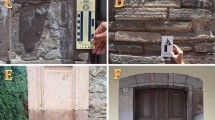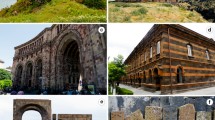Abstract
In the Hessian region of Germany numerous deposits of tuffs are known from which natural building stones were extracted. Many buildings show examples of the use of this material in the past. In contrast to their attractive appearance and ease of extraction from quarries, tuffs are liable to destruction by weathering. Most common damages are disintegration, crumbling, cracking, scaling and flaking. In this paper, the causes of damage of selected varieties have been analysed using petrographical and petrophysical methods. The measured values are disadvantageous in comparison to other natural building stones. Large amounts of swellable clay minerals, mostly forming the cementing material, cause scaling due to repeated humidification. High porosity including negative pore structures and high adsorption effects results in structural damages while freezing. Consequently, most varieties of the described tuffs possess a limited usage as an outdoor building material.
















Similar content being viewed by others
References
Auras M (1998) Der Habichtswald-Lapillituff als Naturwerkstein. Denkmalpflege Kulturgeschichte 2:48–57
Auras M, Egloffstein P, Steindlberger E (2000) Vulkanische Tuffsteine: Entstehung, Verwitterung, Konservierung. IFS-Bericht 10:35–52
DGZfP-Ausschuß für zerstörungsfreie Prüfung im Bauwesen (AB), Unterausschuß Ultraschallprüfungen (1993) Merkblatt für das Ultraschall-Impuls-Verfahren zur zerstörungsfreien Prüfung mineralischer Baustoffe und Bauteile
DIN 52 102 (1988) Bestimmung von Dichte, Trockenrohdichte, Reindichte, Dichtigkeitsgrad und Gesamtporosität
DIN 52 103 (1988) Bestimmung von Wasseraufnahme und Sättigungswert
DIN 52 105 (1988) Druckversuch
DIN 52 106 (1994) Untersuchungsverfahren zur Beurteilung der Verwitterungsbeständigkeit
DIN 52 450 (1984) Bestimmung des Schwindens und Quellens an kleinen Probekörpern
DIN 52 617 (1987) Bestimmung des Wasseraufnahmekoeffizienten von Baustoffen
Egloffstein P (1998) Vulkanische Tuffsteine als Werksteine an historischen Bauwerken in Ungarn und Deutschland, Verwitterungsverhalten und Konservierungskonzepte
Fitzner B (1970) Die Prüfung der Frostbeständigkeit von Naturbausteinen. Geol Mitt 10:205–296
Fitzner B (1994) Volcanic tuffs: the description and quantitative recording of their weathered state. In: Charola AE, Koestler RJ, Lombardi G (eds) Lavas and volcanic tuffs. Proceedings of the International Meeting. Easter Island, Chile, 25–31 October, 1990, pp 33–51
Grimm W-D (ed) (1990) Bildatlas wichtiger Denkmalgesteine der Bundesrepublik Deutschland. Bayer. L.-Amt Denkmalpflege, Arbeitsh. 50
Grissom CA (1994) The deterioration and treatment of volcanic stone: A review of the literature. In: Charola AE, Koestler RJ, Lombardi G (eds) Lavas and volcanic tuffs. Proceedings of the International Meeting. Easter Island, Chile, 25–31 October, 1990, pp 3–29
Helas V (1992) Erhaltung einer künstlichen Ruine. Naturstein 2:22–25
Romberg H (1978) Zementsteinporen und Betoneigenschaften. Beton-Informationen 18(5):50–55
Steindlberger E (2002) Untersuchungen zum physiko-chemischen Verwitterungsverhalten hessischer Tuffsteine. Frankfurter Geowiss Arb A 20
Steindlberger E (2003) Vulkanische Gesteine aus Hessen und ihre Eigenschaften als Naturwerksteine. Geol Abh Hessen 110
Steindlberger E, Auras M (1999) Hessische Tuffsteine und ihr Verwitterungsverhalten am Bauwerk. In: Wittmann FH, Gerdes A (eds) Werkstoffwissenschaften u. Bauinstandsetzen V:1483–1494
Wendler E (1991) Zum Mechanismus der Schalenbildung bei tonigen Sandsteinen. Jahresberichte Steinzerfall-Steinkonservierung 1989:71–76
Author information
Authors and Affiliations
Corresponding author
Rights and permissions
About this article
Cite this article
Steindlberger, E. Volcanic tuffs from Hesse (Germany) and their weathering behaviour. Env Geol 46, 378–390 (2004). https://doi.org/10.1007/s00254-004-1039-7
Received:
Accepted:
Published:
Issue Date:
DOI: https://doi.org/10.1007/s00254-004-1039-7




